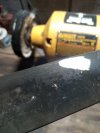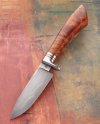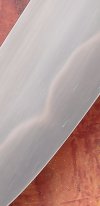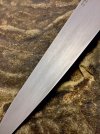- Joined
- Feb 16, 2022
- Messages
- 615
So I've been working on this 52100 knife. I posted a pic in the whats going on in the shop thread but ill show one below.

This picture was basically directly after pulling it out of the ferric chloride, neutralizing it. Then spraying it with wd40 to get any moisture out.
I've tried a lot of things to get this banding to show like I want it to, and I am just really having a hard time getting the contrast i want. What I'm finding is, if i do the normal methods of etching I might do for a hamon, or other things with ferric. When i wash off the excess oxidation. The detail goes with it. Ive tried a good few things but the best so far was letting it sit 24 hours with wd40, then wiping it. But that still doesnt leave me with as much detail as i think can be achieved.
Without making this a novel, I'll say ive tried a good few other methods. Like the hybrid polishing method. Which is giving some results, but isn't popping that much still. It might more after another, 10 or 20 more polishing, and acid cycles.
If anyone has any advice or experience getting carbide banding to show up. I would be grateful for any advice.

This picture was basically directly after pulling it out of the ferric chloride, neutralizing it. Then spraying it with wd40 to get any moisture out.
I've tried a lot of things to get this banding to show like I want it to, and I am just really having a hard time getting the contrast i want. What I'm finding is, if i do the normal methods of etching I might do for a hamon, or other things with ferric. When i wash off the excess oxidation. The detail goes with it. Ive tried a good few things but the best so far was letting it sit 24 hours with wd40, then wiping it. But that still doesnt leave me with as much detail as i think can be achieved.
Without making this a novel, I'll say ive tried a good few other methods. Like the hybrid polishing method. Which is giving some results, but isn't popping that much still. It might more after another, 10 or 20 more polishing, and acid cycles.
If anyone has any advice or experience getting carbide banding to show up. I would be grateful for any advice.



